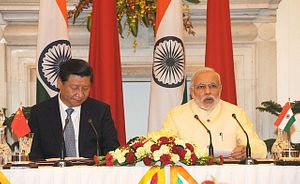The new Indian government headed by Prime Minister Narendra Modi has pursued its foreign policy with exceptional vigor. One bout of “fast track” diplomacy came to an end with his euphoric visit to the U.S. and another has just begun with Modi hosting Vietnamese Prime Minister Nguyen Tan Dung. The first round also included successful visits to Bhutan, Nepal and Japan. The visit of Australian Prime Minister Tony Abbott to India was likewise a success, even if understated. The success of the summit with Chinese President Xi Jinping however, cannot be stated as convincingly. Xi was given a grand welcome in Ahmedabad by Modi. In Delhi, Xi committed to a $20 billion investment in India over five years, yet while they were touring Gujarat, hundreds of PLA soldiers crossed the border into the Indian territory of Chumar.
Past Trends
The larger question is: Why did China choose to do this? Why did it send such a mixed signal at such an inopportune time? An easy answer can be found by looking at past trends. Previous visits of Chinese presidents and premiers have been a means for delivering disguised messages. The 2013 visit by Premier Le Keqiang was preceded by PLA soldiers camping on the Depsang Plains of Ladakh. Just a week before the arrival of Premier Wen Jiabao in 2006, the Chinese envoy to India Sun Yaxi declared Arunachal Pradesh to be part of China. The history of calculated measures coinciding with high-profile visits should have prepared India for similar actions this time. It was the scale of the incident (with reportedly 1000 PLA soldiers participating) and the timing that took Indian strategic thinkers aback.
Battle of Influence Over South Asia
The more complex and nuanced explanation of what happened in Chumar can be found in a book published in 2001. Protracted Contest by John W. Garver explores in detail the Sino-Indian rivalry during the twentieth century. A substantial part of the book focuses on their competition for influence over South Asia. Traditionally India has considered South Asia to be its sphere of influence. Various smaller nations of South Asia have found themselves locked in an asymmetric relationship with India, whose size and economy overshadows them. In their quest to counter perceived Indian hegemony, they have often reached out to China. Not having the best of bilateral relations with India, China has keenly established diplomatic, economic and even military relations with many of the countries.
India has always been wary – perhaps justifiably – of Chinese links with South Asian nations. China, with its ally Pakistan, has strategically outflanked India on its northwestern border. India has always felt similarly threatened on its northeastern border by the China-Myanmar alliance. In response, India has tried to dissuade other South Asian nations from developing military ties with China in order to protect its security concerns. China on the other hand has always asserted that India should treat its South Asian neighbors as equal, sovereign nations with the freedom to chart their respective foreign relations, including with China. Beijing’s strategy of containing India involves eliminating South Asian solidarity.
India’s Neighborhood Focus
The very first step that Modi took after being elected was to reinvigorate SAARC by inviting the group’s respective heads of government to his swearing-in ceremony. Tibetan Prime Minister in-exile Lobsang Sangay was also invited, which further antagonized China. Modi’s first two foreign visits to Bhutan and Nepal clearly underscored the importance he accords to the neighborhood. Both Nepal and Bhutan have in the past tried to develop independent relations with China to counter perceived Indian dominance. In 1988, despite India’s warnings, King Birendra of Nepal purchased antiaircraft guns from China. In the same year, Nepal and China concluded a secret intelligence exchange agreement. Upset by these moves, India imposed an economic blockade on Nepal. China could not help Nepal because of the geographical challenges in transiting goods over hostile terrain. Having learned a lesson, Nepal began to appreciate India’s security concerns. In his first trip, Modi struck a chord with Nepalese leaders, allowing for a review of the Treaty of Peace and Friendship of 1950, which has been a longstanding demand of its Himalayan neighbor.
Bhutan has also at times tried to develop greater relations with China, albeit with only partial success. India has kept a close watch on Sino-Bhutanese relations because Bhutan forms an important part of India’s northeast security. Bhutan along with Indian state Sikkim help India to outflank China if the PLA proceeds toward the Siliguri Corridor – the tiny sliver of land that connects northeast India with the rest of the country. Narendra Modi’s visit to Bhutan was timed just ahead of the 22nd round of bilateral dialogue between Bhutan and China on border negotiations. China claims a portion of north-western Bhutan in the Chumbi Valley region. As far as India’s security establishment is concerned, this concession to China is a red line.
In essence, Modi’s attempt to consolidate South Asia as an Indian-led bloc has not gone well. China cannot leave South Asia to Indian influence while harboring visions of its own pre-eminence in Asia. The incident in Chumar was an attempt by China to reassert its own regional influence.
Kunal Singh is a Research Associate at the Centre for Policy Research (CPR). Follow him on Twitter@kunaldrajput.

































